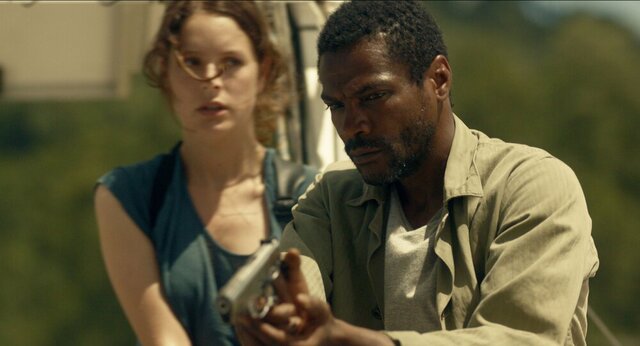 Environment is a thing. Some would argue it’s a very important thing, shaping who we are as people just as much – if not more – than the society we’re born into. They contrast one another visually and uniquely shape our perception. They do some other stuff, too, but that’s another article altogether; I digress... ...Horror uses this to its advantage by giving us creepy pitch-black abandoned hospitals, with something lurking around every corner. Iskander: Shadow of the River uses this concept to craft a compelling story, set amongst a backdrop not commonly seen in horror. Created by Aurelien Molas, Iskander is a Shudder exclusive series revolving around a rookie cop named Chloe (Stephane Caillard) who is transferred to the jungles of French Guiana, where she is team with local cop Dialo (Adame Niane). Together, they are forced to solve the ritualistic murder of a French couple from the mainland. Things start off “simple” enough: It’s referenced many times that Chloe was sent there due to some past indiscretion (FORESHADOWING?!?!?!), though she’s confident her jungle training camp has prepared her for the immersion. After she’s paired up with Dialo, a few things become clear right away:
You may be asking yourself: Zach, does this always have to be about race? And the answer is no, but it’s relevant here so we’re going to talk about it. Right off the bat, the cultural differences between our two protagonists have them at different ends of the spectrum. On top of that, they just plain don’t like each other. As horror fans, what do we all know is a great way for two people at odds to bond? A vicious, bloody, and slightly supernaturally-motivated murder, of course. Iskander has an interesting premise – more crime than horror (no complaints from me about that – and takes things further by using an environment not commonly seen in horror. It’s a lush jungle. There’s flora and fauna everywhere. It’s usually pretty bright. The dichotomy between the setting here and a more commonly used aforementioned creepy dark abandoned hospital is used extremely well to subvert our assumptions. Flow-centric camera work heightens the atmosphere while utilizing static shots and quick-cuts to build tension in the first episode. We see the environment soon become isolating and claustrophobic, aided by well-done cinematography and music score. Though it’s a bit off-putting at first, it’s quickly established this atypical setting is used to full advantage. As the plot advances, we see Chloe and Dialo both focused on the murder case, but also focused on not liking each other at all. They look to different leads, past behavior comes back to haunt them, and their mutual dislike also leads one of them to nearly die. Though the plot itself isn’t terribly unique, it’s interesting enough and further cemented with solid acting and a great backdrop. The story isn’t afraid to dive into the cultural/racial tension either, bringing up a very different, but equally unsettling element of fear. The story isn’t afraid to give in to some usual horror tropes with its characters: of course Chloe has a shady past and Dialo has his own mysteries from his early days, but it’s never too much to seem disingenuous. The show is further strengthened by successfully utilizing the TV series vs. single movie medium, having enough tension spread out to never seem it was taking too long or losing out by not exploring subplots. With a consistent and quickly advancing plot, solid acting, great camera work and set design, Aurelien Molas’ Iskander: Shadow of the River successfully pens out a strange tale of murder and voodoo in the enigmatic jungles of Guiana. Iskander: Shadow of the River is now streaming on Shudder. By Zach Gorecki
0 Comments
Leave a Reply. |
Archives
March 2023
|



 RSS Feed
RSS Feed